Top Story: Health
Learning lessons in healthcare
November 20, 2014
For years, teachers at Sun Valley Middle School used a 1.8-acre dirt expanse on campus to teach students the finer points of horticulture. But when Los Angeles County officials saw the empty land, they envisioned growing something else, something ripe for a neighborhood in need.
In 2008, the Sun Valley Health Center opened its doors, ushering in a new model of grassroots care in the county. Today, the $7.5-million, 11,000-square-foot community clinic racks up more than 28,000 medical and dental visits each year for ailments ranging from asthma to diabetes.
And patients are treated regardless of their ability to pay.
“It’s like a dream come true,” said Helen Arriola, governmental and community relations officer for the Northeast Valley Health Corp., a nonprofit tapped to provide low-cost or no-cost treatment at Sun Valley Health Center.
“There’s such a great need [for affordable care] in Los Angeles County, given the numbers of uninsured here,” Arriola said, recalling the crowds that lined up for vaccines at the health center as early as 4 a.m. during the 2009 swine flu pandemic. “We have to provide them with services — we can’t say ‘no.’”
The concept of school-based health centers has proven so successful that two more will soon become a reality on San Fernando Valley campuses that lie in what Supervisor Zev Yaroslavsky calls “ground zero” in the nation’s healthcare crisis.
The $11-million, 13,500 sq. ft. North Hills Wellness Center at James Monroe High School, which was dedicated last month, is scheduled to start serving patients in January. Meanwhile, construction is expected to soon be completed on the $6.2-million, 5,400-sq. ft. San Fernando Teen Health Center at San Fernando High School.
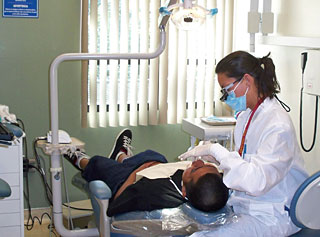
The Sun Valley Health Center has logged more than 28,000 visits annually for medical and dental services.
All three projects are joint ventures between the county and the Los Angeles Unified School District — the former building the health centers, and the latter supplying the land.
They are partnering with several private nonprofit healthcare groups to staff the facilities with physicians, dentists, optometrists, psychologists, nurses and other medical professionals.
“We started looking into health centers on campuses many years ago, because schools are centrally located in the lives of families,” Yaroslavsky said the recent dedication ceremony for the North Hills Wellness Center.
“This is an effort to take the real estate used by schools, and build things into it that would not just be looking inward to the schools but outward to the community,” he added.
Yaroslavsky allocated $24.7 million in Third District funds for the three projects, while the LAUSD covered the remaining $1 million.
North Hills Wellness Center, located at the corner of Nordhoff and Haskell, will be the most expansive, with 14 medical, dental and visual examination rooms, mental health and behavioral counseling offices, as well as a dispensary and laboratory.
It will also have a Teen Health Center that will offer confidential treatment to the growing number of youths dealing with mental illness, substance abuse, homelessness and other problems.
“This community is home to about 400,000 residents, and about 85 percent of them live at or below 200 percent of the federal poverty level — that’s an (annual) income of about $46,000 for a family of four,” said Dr. Roger Peeks, chief medical officer of Valley Community Healthcare, which will operate the wellness center.
“These are the people that we are going to serve,” he added.
The same nonprofit organization behind the Sun Valley Health Center will also operate the San Fernando Teen Health Center. Arriola said Northeast Valley Health Corp. is currently soliciting donations to buy furniture and medical equipment.
Initially, the teen center will treat only students from San Fernando High School, Mission Continuation School and McAlister School. But Arriola is optimistic that the clientele will expand.
“If you look at the construction site, the main door faces the street, and what we’re hoping is that sometime in the future, they’ll allow it to be open to the community, perhaps after-hours or on Saturdays,” she said.
The county’s community health programs director believes the school-based health center model should be replicated over and over again.
“What we know in pediatrics is that over half of the sick low-income kids in the US also have sick parents and sick friends, and the opportunity to serve them in one place is unusual, forward-thinking and fantastic for those families,” Dr. Mark Ghaly said. “We look forward to seeing this idea spread to more places,” he added.
New recruits in war on flu
October 23, 2014
It’s a scary, potentially deadly communicable disease, and it could be coming soon to your neighborhood, school or workplace.
But unlike Ebola, which has been commanding worldwide media attention in recent weeks, influenza can be prevented with an effective, widely-available tool that you can get even at the corner drug store or supermarket.
We’re talking, of course, about the good old annual flu shot—which is being promoted in more varieties than ever this year, from nasal spray for kids to high dosages for seniors to vaccines that include an extra strain of virus for good measure.
With Ebola fears running high, county Department of Public Health officials are making a special push to persuade people to get immunized early in the season—whichever type of vaccination they choose—so that they don’t come down with the flu. Since flu can have some Ebola-like symptoms (including fever) it makes sense to minimize the number of people who get it and then head to the emergency room fearing the worst.
In other words, flu vaccinations may be an easier sell this season than they have been in years past.
The Ebola situation has created a “teachable moment,” said Michelle Parra, the director of Public Health’s immunization program. She said it is a chance to drive home the message that flu can be serious and even fatal, especially to those with underlying medical conditions or overall frail health.
Ebola has killed thousands in Africa, but at this point only two people are believed to have contracted the disease in the United States—both of them nurses who treated Thomas Eric Duncan, who was infected with the disease in Liberia and later died from it at a hospital in Texas. Flu, on the other hand, claims the lives of tens of thousands of Americans each year—up to 49,000 annually, according to the Centers for Disease Control. Those stricken include the 105 Los Angeles County residents—101 adults and four children— who died during the last flu season in 2013-14. That was the highest death toll in the county since the H1N1 pandemic of 2009-10, when 127 died.
No deaths and only “sporadic” flu activity have been reported to L.A. County so far this season, which officially runs from November 1 to March 31. But the county Department of Public Health emphasizes that it’s important to get the vaccine early, since it takes about two weeks to take full effect against flu viruses.
While the overall message is to get the vaccine, period, and as soon as possible, a number of new choices have been cropping up—giving consumers a robust array of options to talk over with their health care providers.
One is the first official recommendation that children aged 2 to 8 get nasal spray instead of a shot, unless they have a condition like asthma. The nasal mist also can be given to adults up to the age of 49.
Then there’s the high-dose vaccine for people 65 and over, which, according to a study recently reported in the New England Journal of Medicine, offers more protection for seniors than the traditional vaccine.
Finally, for the second year in a row, there are two different kinds of vaccine blends on the market—one containing three strains of viruses that cause the flu, the other made up of four.
While that’s good news overall (it indicates that manufacturers are becoming increasingly responsive to flu viruses circulating in other parts of the world before they reach the U.S.) it does present a bit of a communications quandary for health officials, according to L.J.Tan, chief strategy officer for the nonprofit Immunization Action Coalition.
That’s because the four-strain, or quadrivalent, vaccine accounts for only about half of the available vaccine. The CDC estimates that 76 million doses of the quadrivalent will be produced this season, while the rest of the 151 to 156 million doses that make up the nation’s total supply will be three-strain, or trivalent.
“We think it’s most important to get vaccinated [with whichever vaccine is most readily available.] We don’t want people going around saying, ‘Oh, the quadrivalent has four, it’s better, therefore I’m going to wait.’ Because by the time they wait it could be too late,” Tan said. “That’s one of the messaging nuances that we’re trying to figure out and get out there.”
Tan said researchers play a guessing game each year as they try to predict the virus strains heading our way in the coming flu season. The so-called B-strains are generally considered less lethal but are harder to predict, so the quadrivalent vaccine doubles down and includes both. The A-strains, meanwhile, are the most deadly, so both the trivalent and quadivalent vaccines include them—and that’s why health officials say it’s better to get a timely shot than to waste too much time shopping around.
In the midst of this expanding universe of vaccine choices, meanwhile, officials warn consumers not to be sidetracked by claims that flu shots give you the very disease you’re trying to avoid. “Flu shots cannot give you flu,” Public Health’s Parra said. “What happens is a lot of time people already have flu in their system” and wrongly attribute it to the vaccination they just received.
Finally, health experts emphasize that we’re all in this together. Even if you don’t feel personally vulnerable, it’s a good idea to get vaccinated to help those who are more susceptible.
“There’s so many people trying to push different messages, and I do think this idea of ‘Do it for your grandma’ is the one the CDC tries to lead with,” said Tan, of the Immunization Action Coalition. “Protect yourself, protect your family.”
More tips from the county Department of Public Health are here.
Posted 10/23/14
At the ready for Ebola in L.A. County
October 17, 2014
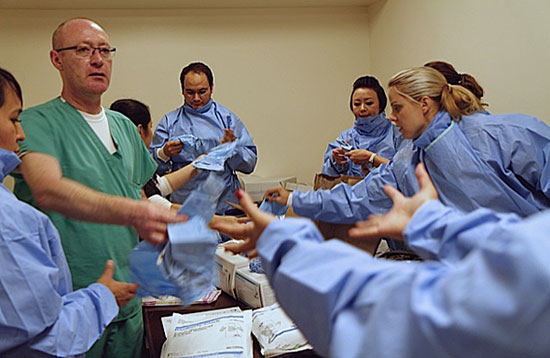
Nurses at LAC+USC hospital this week learn how to protect themselves from Ebola with protective gear.
When LAC+USC Medical Center handed out its latest batch of protective gear against the Ebola virus Wednesday, several emergency room nurses eagerly reached out with both hands.
There were impermeable gowns, scarves, booties, hair coverings, face shields, goggles and gloves – boxes and boxes of them. Still, the offered protections were not enough to ease the anxieties of at least a few of the nurses who’d gathered in the facility’s conference room.
After all, two members of their profession had, stunningly, contracted Ebola in a well-known Dallas hospital while extensively treating a patient who would succumb to the deadly disease.
One of the nurses at the LAC+USC training session, for example, worried whether the back of her neck was still exposed after she’d slipped on her blue gown. A tall, male nurse, meanwhile, wondered what might happen if his large feet tore through his protective booties.
Observing the session was nurse Jason Guzman, 33, who’d already been training for more than a week at the Los Angeles hospital, which is operated by the Department of Health Services. He understood the importance of those questions and concerns because before his training, he had them, too. For with Ebola, even the slightest wardrobe malfunction can lead to infection.
The training, he said, “helped me get more comfortable with the gear. It’s really boosted my confidence. It’s helped me feel a bit better about the situation.”
According to the World Health Organization, the current outbreak of Ebola Virus Disease has infected some 8,900 people, killing about 4,500 of them. That’s more than all other previous Ebola outbreaks combined. Among the casualties: 256 healthcare workers.
Although West Africa remains the epicenter of the disease, the patient in Dallas succumbed after a visit to Liberia, infecting two nurses who’d cared for him.
According to Los Angeles County’s interim health officer, Dr. Jeffrey Gunzenhauser, the nurses’ infections underscore the need for healthcare workers and others to take extreme precautions if they come into contact with a patient who may be contagious.
“I feel personally responsible for their safety,” he said.
Ebola, first discovered in 1976, can cause fatal hemorrhagic fever. A person can get sickened through direct contact with an infected person’s bodily fluids. The first symptom is fever, followed by headache, weakness, diarrhea and severe bleeding.
Gunzenhauser is concerned but calm, even unruffled. That may be because he’s not only a doctor but a retired Army colonel, whose resume includes graduation from West Point, medical training at Walter Reed Army Hospital and drafting health policies for soldiers deploying to the wars in Iraq and Afghanistan. He even learned to parachute out of planes, should that be the only way to reach wounded soldiers on the battlefield.
“Coming out of the military, I’m very accustomed to working in highly stressful operational environments and approaching problems with greatly detailed plans,” he said.
Last week, Gunzenhauser and other county leaders convened a task force to evaluate the response to Ebola if it were to reach Los Angeles. He knows that patients would need more than just medical care.
That’s why beyond medical, emergency and law enforcement agencies, the task force includes such departments as Children and Family Services, Mental Health and Public Social Services.
“Let’s say, for example, we might have a case where we would need to quarantine a family,” he said. “How are they going to get their food? What if they need medications? What if we’re pulling a kid out of school? We need to look at all those contingencies, and plan for them.”
If preparing for Ebola is like mounting a military campaign, then nurse Jason Guzman is among those on the front lines. He feels a “calling” to be a nurse, despite knowing that taking risks is “part of the job description.”
“Nurses are in the field to care for those who need help, and Ebola patients aren’t any different,” Guzman said. “They definitely need care — a little bit more care, perhaps.”
“I just know that if there’s a situation where there’s possibly a patient with Ebola, I’m going to do everything i can to help them,” Guzman said. “I’ll also definitely do everything I can to protect myself.”
Posted 10/17/14
Cracking the ER “Code”
August 13, 2014
In the beginning, the idea was simply to produce some archival footage—a project pitched by a young medical student to document life-saving efforts unfolding amid the controlled chaos of the emergency room at Los Angeles County’s old General Hospital.
It was there, on the edge of downtown, that the concept of emergency medicine was born in 1971 and, in some respects, had remained the same in theory and practice throughout the ensuing decades.
Despite medical modernizations that had become the norm at most hospitals, the emergency crew at the renamed Los Angeles County-USC Medical Center still operated more like a battlefield MASH unit. Crowds of doctors and nurses swirled around patients suffering the most catastrophic of injuries. Side by bloody side, the stricken were packed into a cramped trauma bay in the ER called “C-booth,” with barely a curtain between them.
But in 2008, all that was about to change, and first-year resident Ryan McGarry, who also had a keen interest in filmmaking, wanted to capture the era before it was gone. Because of earthquake damage to the old county hospital, the emergency department was moving next door to a new state-of-the-art facility that would rocket the doctors into 21st century medicine, complete with its emphasis on patient privacy and layers of paperwork.
Although initially modest in scope, McGarry’s ambitions for the project soared with the support of top Los Angeles County officials and the help of a producing team that included USC Distinguished Professor Mark Jonathan Harris, who has won three Academy Awards for documentaries.
McGarry’s film, Code Black, opened nationwide in June and has become a critical success, a gripping and graphic look at the shifting world of emergency medicine for the destitute and working poor who rely on public hospitals, such as County-USC, for their care. The term Code Black refers to the hospital’s designation for the highest level of emergency room crowding. Among other honors, the film won the Jury Award for best documentary at the 2013 Los Angeles Film Festival.
Focusing on a cadre of idealistic young residents, including himself, McGarry explores the challenging new realities for the next generation of emergency room physicians as they remain committed to maintaining a personal connection with patients while confronting the escalating regulatory demands and settings that emphasize patient privacy.
Dr. Sean Henderson, chairman of the hospital’s emergency department, says his 21-year-old daughter saw the documentary at a film festival in Santa Barbara and was so inspired that she changed her major.
“She decided to become a physician’s assistant because of that movie,” he said.
“Often, doctors are portrayed as overpaid snobs who don’t really care,” he continued the other day, sipping a caffeine-free Coke in his office in the old county hospital. “But I think you’ll see in this movie that this is not always the case. There are people doing things because they really care about the people they serve.”
Still, Henderson said he has some personal reservations about the film—a project he inherited from his predecessor, Edward Newton—and isn’t sure he would have green-lighted it himself.
“I’ve never believed in cameras in the hospital,” he explained. “The fact that you’re in an emergency room with an unplanned, unscheduled, unanticipated event—stressed, waiting, probably less informed than you’d like to be—I think that’s a very vulnerable place to be.”
That said, Henderson praised the filmmaker for getting two sets of consents from patients whose emergency room visits are shown in the film—everyone from a drunken man belting out a romantic ballad in the waiting room to the family of a patient whom doctors unsuccessfully fought to save as they cut into his chest to keep his heart beating.
Henderson, who became department chair in 2012, also appears in the film, but mostly to defend a prominently featured action he imposed in the face of a severe nursing shortage. In a dramatic segment of the documentary, he shut down an area of the new emergency department, creating a monumental patient backlog, to make the point “that we couldn’t continue to care for all these people with inadequate resources.”
“I caused the crisis and I had to defend the crisis. I was the villain,” he said, and then offered a fuller explanation of his actions than he did in the film.
He said that in the past, before Health Services Director Mitchell Katz’s arrival in 2011, “the way you got attention in the county system was to create a crisis. It wasn’t just me. It was throughout the system…If you have a crisis, resources are pulled from someone who’s not having a crisis to take care of your crisis. And so, without permission from the school [USC] or the county, I created a crisis knowing full well that it would create a pushback downtown that would allow them to hear my pleas that heretofore had gone ignored.
“It was manipulative, it was sneaky, and mea maxima culpa. But it worked,” he said, noting that more funding was soon made available for the desperately needed nurses.
Another top L.A. County emergency department official, Dr. Erin Wilkes, said she’s seen her good friend McGarry’s film more than a dozen times in various stages along the way. The two were residents together, beginning in the old hospital’s emergency department. Today, she’s the director of Emergency Medicine Systems Innovation & Quality.
Wilkes said she helped organize various Code Black screenings for county officials, including the Health Services executive team. The feedback was mostly positive, she said, although “there were a lot of questions about what the consent process was like.” Wilkes said McGarry obtained his first consents at the hospital and then got a second round of permissions after showing people the actual footage he wanted to use.
Wilkes said she’d now like to build on Code Black’s positive buzz by holding a panel discussion event at USC that would include McGarry, now an assistant professor of emergency medicine at New York-Presbyterian/Weill Cornell Medical College.
In a recent interview with the emergency medicine publication ACEPNow, McGarry talked about the demands of simultaneously pursuing his residency and filmmaking. “It was three years of no vacation,” he said. But he said he had no regrets.
“One thing that I feel very lucky to have experienced,” he said, “is nonmedical people sitting through some pretty tough stuff in cases we show. And at the end of the film people give us a standing ovation. I wish I could share that with every physician, nurse and X-ray tech who leaves a really tough shift.”
Posted 7/17/14
A heads-up on concussion risk
June 26, 2014
You’ve seen the recent headlines: Contact sports often lead to concussions, with possible long term effects. Earlier this month, former Miami Dolphins quarterback Dan Marino and 14 players became the latest to sue the NFL over concussions. Last year, PBS’ Frontline program League of Denial won a Peabody Award for investigating the NFL’s concussion crisis.
The story does not end with professional or even college sports: Studies show high school athletes are at double the risk of concussion as college players. Experts are also concerned about the cumulative effect of repeated concussion, which has been linked to temporary and permanent changes in the way the brain functions.
Heightened awareness is leading more young athletes to seek medical evaluation for possible concussions. The State of California has required concussion training for school coaches since Jan. 1, 2013.
Now, a new report by the Los Angeles County Department of Public Health provides a first-ever look at the problem of concussions in the L.A. region—and how rising awareness is leading to more and quicker treatment.
Overall, researchers found that 69,000 people were treated in emergency departments or admitted to hospitals in the county for concussions between 2005 and 2011. During that time, hospitalizations remained steady but the rate of emergency room visits soared by 58%–a finding that public health officials say reflects the public’s growing understanding of concussion symptoms and the importance of seeking medical attention.
By far, the highest rates of emergency visits were for young adults between the ages of 15 and 24. They accounted for nearly 30% of all such visits, almost twice as high as for any other age group. Roughly half of those individuals were hurt while playing football, with another 20% suffering injuries during soccer games. (Falls were the main cause of concussions among all age groups in L.A. County.)
While these findings were not unexpected for this younger age group, researchers were surprised by one unexplained discovery: Females, they found, reported more concussions than men in sports in which both play under similar rules, including basketball and soccer.
“It could be biomechanical, the way females are built versus males,” said Dr. Margaret Shih, director of the public health’s office of health assessment and epidemiology. She said it’s hard to draw a conclusion because women are traditionally more likely to seek medical help than men. “There’s still a lot of research that needs to be done,” she said.
County health officials say they hope their report will lead to heightened awareness not only in our emergency rooms, but on the playing field. And despite the rising numbers of emergency department visits, they think the numbers are still too low.
“I do believe that concussions are underreported,” said Andrea Welsing, director of the injury and violence prevention program for the public health department. She added that pressure to play is still keeping many injured athletes in the game, putting them at risk of further injury.
Although the report will not be distributed in hard-copy form, Welsing said the plan is to launch an e-mail campaign to include parents, coaches, teachers, pediatricians, sports medicine physicians, recreation center personnel and school nurses.
Welsing said the health department is not expecting schools and other youth sports organizations to hire additional medical staff, but rather to train coaches and others to recognize symptoms and realize the importance of taking a player out of the game until he or she can be medically evaluated.
Steven Grech, assistant athletic director for sports medicine and head athletic trainer at California State University, Northridge, said his university has done baseline testing for concussion for all contact sports since 2006. But the effort became more formalized in 2010, when the NCAA began requiring Division 1 institutions, including CSUN, to have a formal concussion management plan.
The biggest recent improvement at CSUN is in student awareness —the 2010 requirement included student education along with faculty training. Grech said CSUN fosters a culture where players look for symptoms in their teammates and roommates, not just themselves. This is particularly important during the summer, when there are no official team practices but athletes are still playing to stay in shape, Grech said.
“We have kids coming in saying, ‘Hey, I was playing pickup basketball just last night and got hit in the head and I’ve had a headache ever since, I couldn’t sleep last night, I’ve been dizzy,’” Grech said. “We’ve seen an increase in self-reporting over the last four years.”
Posted 6/26/14
Texting while thriving
May 22, 2014
We’re a nation of texters, LOL’ing our way to instant (and addictive) connection and communication with those around us.
But those messages don’t have to be mundane, goofy or superficial. In fact, some of them have the potential to save—or at least improve—lives.
Beginning in June, members of Dr. Theodore Friedman’s obesity group at the county’s Martin Luther King, Jr. Multi-Ambulatory Care Center will begin receiving text reminders, tips and other information designed to empower them to stick to health goals. In the new program, the mobile phone acts as a virtual health coach between visits to the doctor.
Maybe it’s a reminder: Zumba class at 4 p.m. Or this techno-friendly nudge: “Did you meet your goal of eating a healthy breakfast today?” Or it could be a “mood” question: “How did you feel when you found out that you had high blood pressure?” If you chose “confused,” another text assures you that your feelings are normal.
“This is a way to harness technology that everybody is using and embracing,” said Dr. Ellen Rothman, interim medical director for the health center. The technology does not allow for live text conversations with the doctor, but between appointments, an automated reminder is next best thing, Rothman said.
This week the County Board of Supervisors approved an agreement between the care center, Charles R. Drew University of Medicine and Science and CareMessage, Inc. to begin a pilot program with about 200 patients who are part of the obesity group, which has been in existence for about 16 months. The initial $500-a-month program is paid for with grant funds from Drew University so there is no direct cost to the county.
“We are going to break down…therapeutic goals into bite-sized pieces,” Rothman said. “A goal might be: I’d like you to walk for 30 minutes a day. I’d like you to cut out that cereal and milk at bedtime that everybody thinks is so healthy; I’d rather have you eat a slice of bread with some peanut butter that’s more filling and nutritional.”
The CareMessage program is not set up to offer advice quite as personalized as Rothman’s. But it can provide a menu of customizable programs designed for specific problems. Options include teen pregnancy, stress management, stress monitoring, smoking cessation or nutrition.
During an initial consultation with a medical professional, the patient will work with the doctor to set up his or her own mobile device to receive text messages. The patient can choose the frequency of reminders or customize a diet or exercise program to their age, weight or fitness level. CareMessage programs are available in English and Spanish.
Friedman chose the obesity group for the pilot because obese patient health care often calls for lifestyle changes rather than medications. That’s where the text-coaching can help, he observed.
“Obesity is not a medical disease,” Friedman said. “This is all about motivation.”
While the text messaging program has not yet begun, current hospital efforts and research point toward potential success. Low-income patients may not have computers or land-line telephones, but 70 to 80% of the care center’s low-income patients have mobile phones with texting capability. “And that’s going to go up each year,” Friedman said.
The facility has seen great improvement in the number of patients showing up for scheduled appointments if they get telephone reminders, but calling is labor-intensive and often results in no answer. Automated texts would not only save time and effort but could also reach a greater number of patients.
If the program expands, the technology may also make it easier for the hospital to gather survey information, too. Paper survey forms can be off-putting but with the new system, “you can do it on your phone while you are waiting for an elevator,” Friedman said.
But key for obesity patients, doctors say, is increasing the odds of lifelong behavioral changes. Among MLK’s economically disadvantaged clients, doctors say they’ve observed an uptick in health literacy over the past 15 years. Still, misinformation abounds, including a widespread belief that clear soda is healthier than colored soda.
“I like the idea of touch points, or teachable moments,” Rothman said. “We have limited resources and a lot of patients. It’s an interesting opportunity to catch people in their teachable moments.”
Posted 5/22/14
3 dead in possible meningitis cluster
April 2, 2014
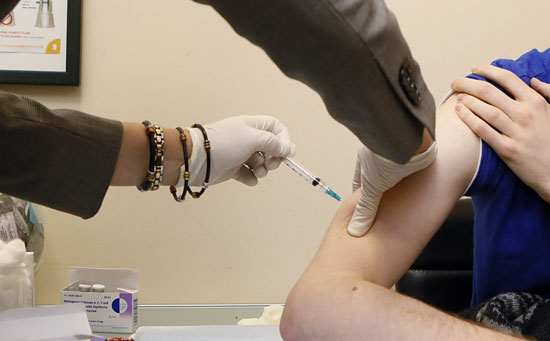
A possible cluster of meningitis cases has health officials urging vaccinations for those at high risk.
Three people have died and five others have fallen ill from meningitis in Los Angeles County since the beginning of 2014, and patterns in the cases have prompted public health officials to urge vaccinations for HIV positive men and those deemed to be at higher risk for contracting the disease.
Public health officials investigating the eight cases said that four of them involve men who had sex with other men. All three of the dead fall into that category; two of them were HIV positive and one was not.
Among the four cases in the possible cluster involving men who had sex with other men, other potential links include the fact that three of the men lived or socialized in West Hollywood or North Hollywood. The ages of the three who died are also similar—27 or 28, while the fourth, who survived, is 50.
A meningitis outbreak in New York last year prompted the health department there to urge men who had regular intimate contact with other men to be vaccinated against the disease. But Los Angeles County public health officials at the time said that was not necessary here, given a lack of connections between the 2013 cases it investigated.
This year, however, common factors among the cases are prompting a different recommendation from the Los Angeles County Department of Public Health, which consulted with the California Department of Public Health and the Centers for Disease Control and Prevention before issuing its alert.
“The facts are different,” said Dr. Jonathan E. Fielding, the county’s director of public health. “We didn’t have the same commonalities then as we do now.”
Although the risk is “very low for the general population,” county officials said that HIV positive men, as well as those who have close or intimate contact with multiple partners, find sex partners online, or share cigarettes and drugs, are at higher risk for the disease and should visit their health care provider to receive the vaccine. Those at high risk who don’t have insurance can get a free vaccination at a county facility.
The Los Angeles cases are all attributed to the strain of meningitis known as invasive meningococcal disease. It is a “sporadic and uncommon bacterial infection of the blood or the lining of the brain and spinal cord that can affect the entire body,” the Department of Public Health said a news release. “The infection can cause brain damage, hearing loss, and even death.”
It is not spread by casual contact, such as being in the same room with someone who is infected, and is less infectious than the flu. The bacteria responsible for the disease are spread by “very close exposure to sneezing and coughing or direct contact with saliva or nose mucus,” the public health statement said.
Meningitis can be treated with antibiotics but because it progresses quickly, “immediate diagnosis and treatment is imperative,” according to the news release. Symptoms include high fever, stiff neck and “altered mental status.”
Under CDC guidelines in place since 2005, all pre-teens and adolescents should receive the meningitis vaccine. A first injection is given at 10 to 12 years old, followed by a booster shot five years later in order to offer protection when the disease is most common, between the ages of 16 and 21. In addition, people who live in close quarters such as dormitories and jails are also considered high risk and advised to get vaccinated as a matter of course.
Still, Fielding said, even those who have been previously vaccinated should get another shot now if they fall into one of the current high risk groups, and if their vaccination was given more than five years ago.
Posted 4/2/14
Here’s the skinny for 2014
January 9, 2014

Make eating out less hazardous to your waistline by looking for the "Choose Health L.A. Restaurant" sign.
As January unfolds and New Year’s resolutions remain firm, county Public Health officials are offering this reminder: Just say less.
A smaller-portion initiative launched last fall has resulted in hundreds of decals—similar to those issued with the department’s popular letter-grading program—being placed in restaurant windows county-wide. The signs, designating a “Choose Health L.A. Restaurant,” mean that reduced-size options and other healthy choices, especially for kids, are on the menu.
The 800-pound sandwich in the group, so to speak, is Subway, with 640 locations taking part. Italian and Mexican restaurants are also represented, along with L.A. standards like Barney’s Beanery, whose four outlets have signed up.
But there are still challenges, including the recruitment of Asian restaurants.
Scott Chan, program director for the Asian and Pacific Islander Obesity Prevention Alliance, said his group is working with the county on outreach.
“We are still in the beginning stages, and most of the Asian owners we have talked to do not know about the program. I am hopeful as the campaign continues that we will be able to reach these folks,” Chan said in an email. “We truly believe that increased language access with these owners, whether through translated forms or in-person interpretation, will guarantee greater success and healthier communities.”
Public Health’s Linda Aragon said her department has sent letters about the program to 27,000 restaurants in the county, and is also trying to spread the word via its network of restaurant inspectors, who are on the frontlines of local eateries every day.
As for consumers, there seems to be a healthy amount of interest.
“We looked at Google Analytics, and we’ve gotten more than 60,000 page views since October,” Aragon said.
It’s important to keep promoting the program, Aragon said, adding that a formal evaluation of how it’s working is expected in the year ahead.
Meanwhile, Aragon said, resolving to take even small steps toward healthier habits can make a big difference. (Some tips to get started are on the Choose Health L.A. website.)
“We always think it’s a good thing when folks consider starting out the New Year by eating better, starting to exercise, or even quitting smoking,” Aragon said. “Anything we can do to improve people’s lives, and this is a great time to start it.”
Posted 1/9/14
Checking out Obamacare at the library
November 14, 2013
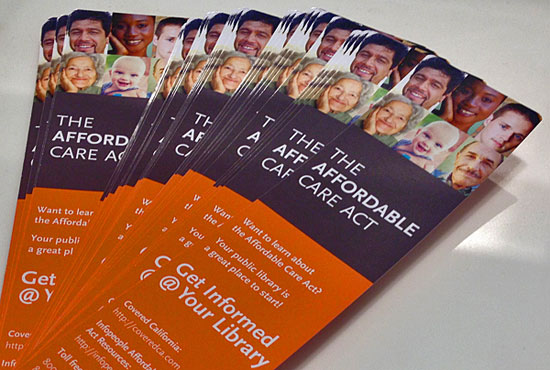
Affordable Care Act bookmarks are available at the info desk at the county's West Hollywood Library.
They don’t wear white coats or wield stethoscopes, but librarians have emerged as preferred providers, of sorts, in Los Angeles County’s massive mobilization to help thousands sign up for health insurance under the Affordable Care Act.
“They reach so many people, and they’re such a trusted source of information,” said Amy Luftig Viste, director of community partner programs for the county’s Department of Health Services. The department has turned to city and county librarians as key partners in a wide-ranging outreach effort that includes handing out brochures and specially printed informational bookmarks, answering basic questions and, at times, reaching out proactively to make sure patrons are aware of the new law and how it could affect them.
Librarians aren’t the only ones out there on the front lines. As the county seeks to draw the attention of hundreds of thousands of uninsured residents newly eligible for coverage under the Affordable Care Act, it has drafted a sometimes unexpected crew of surrogate messengers—ranging from the county Arts Commission to the L.A. City Taxicab Commission—to help get the word out.
The goal: making sure that everybody—even those who might not fit a stereotypical image of the uninsured—knows about their potential benefits under the law.
The health department has “proactively reached out to new populations including taxi drivers, artists, students and recently released jail inmates,” according to a recent report to the Board of Supervisors that also detailed efforts to train city and county librarians on the law.
“One of the challenges we always face is that there is a perception of what the uninsured look like, where the uninsured may live, all of those types of things,” said Tangerine Bingham, deputy director of managed care for the health department. “But we know that uninsured status is across the economic spectrum, and race, ethnicity, occupation.”
Breaking through to various groups and professional subcultures has meant getting creative in thinking about who might qualify for either the state’s new insurance exchange, Covered California, or for Medi-Cal, which is expanding under the new law to extend eligibility to 1.4 million additional Californians. So—beyond partnering with other county departments, such as the Department of Public Social Services—the health department has sought out associations with ties to specific populations, in effect leveraging the organizations’ credibility with their members.
Brochures are now posted at taxi operators’ dispatch centers throughout Los Angeles, and information has gone out to drivers via the mobile display terminals in their cabs. Artists, meanwhile, are being invited to the county Arts Commission on Dec. 5 for an explanatory seminar on “how to get affordable health insurance with the help of tax credits and federal subsidies.”
At libraries, the outreach is broader, building on a growing trend of libraries serving as community centers and repositories of information far beyond the encyclopedias in the reference section.
There are practical reasons for libraries, and librarians, to play a role now.
“We have public computers and we have free WiFi,” said County Librarian Margaret Donnellan Todd, who said librarians knew from the outset that they would be hit with public requests for information as soon as the law rolled out. “We have the ability to kind of navigate [patrons with health care questions] to where they need to be.”
Beyond that, Todd said, librarians enjoy broad public respect as honest and impartial brokers of information. “We don’t have any other motive,” she said.
That’s important, given the controversies surrounding the launch of the system nationally—including persistent glitches on the U.S. website, www.healthcare.gov. California’s exchange, Covered California, has largely escaped the criticism leveled at the national site, although concerns about cancelled policies have been raised here as well as elsewhere in the country. According to numbers released this week, California is leading the country in new enrollments under the law, representing one-third of all Americans who have signed up so far.
“Librarians are getting a lot of questions about the federal website,” Todd said. “But from what I understand, California’s website is in a lot better shape.”
Controversies notwithstanding, questions that library staffers have fielded from the public so far have tended to be fairly basic: “Should I do this? What’s it all about?” said Susan Broman, the county library system’s head of adult and digital services.
Sometimes, Todd said, librarians see the opportunity of reaching out proactively to patrons—like parents and caregivers in the Family Place early literacy program—to make sure they’re getting the information they need about health care reform.
It’s a win-win—for society and for library users of the future.
“Obviously, it’s a very good thing when families have insurance,” Todd said. “One of the things that helps a child get ready to read is a healthy body.”
Posted 11/15/13




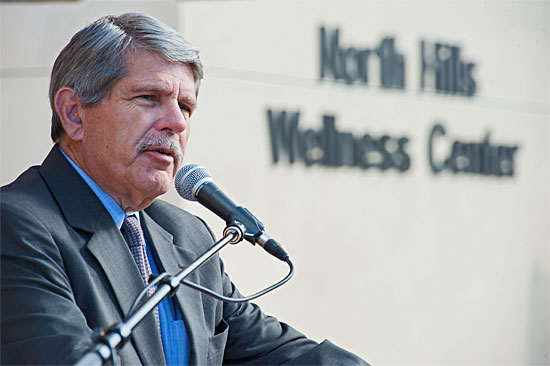
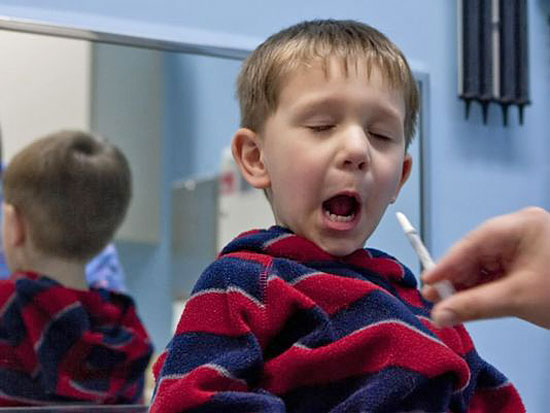

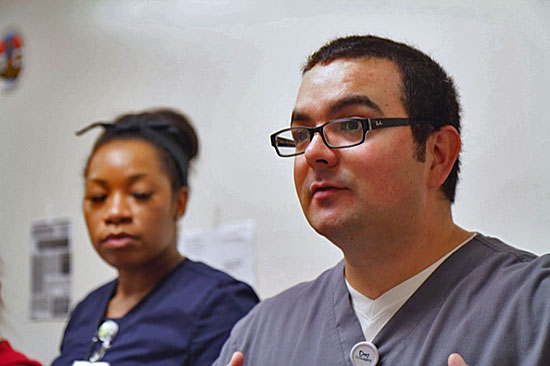
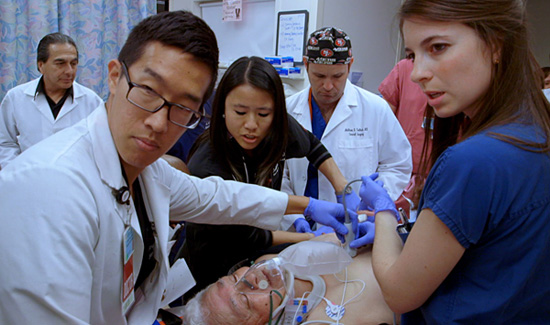
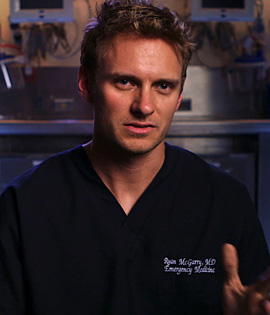
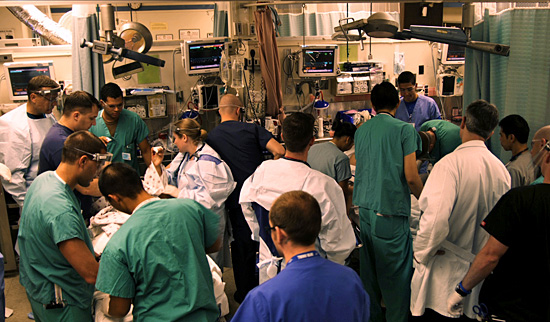

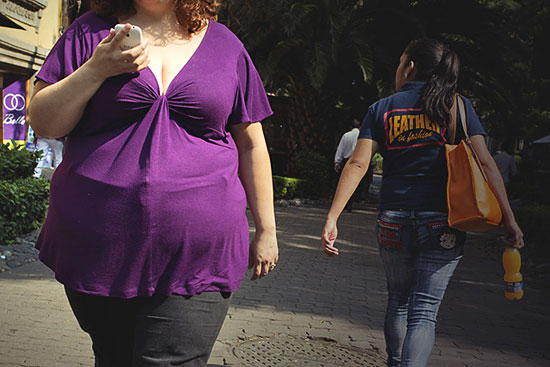
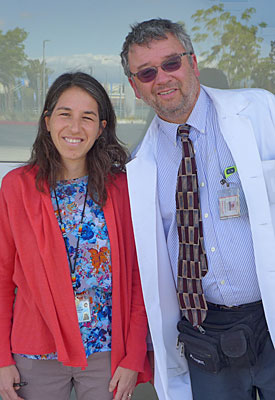
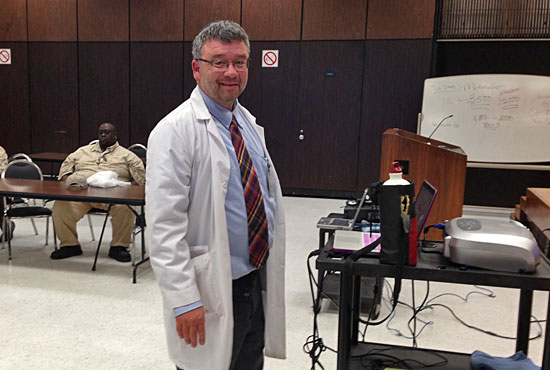
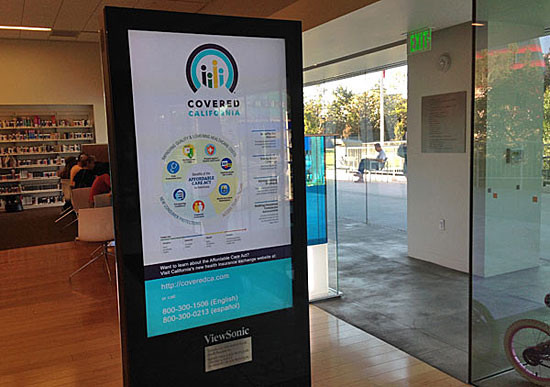







 405 bridge work causes a stink
405 bridge work causes a stink
